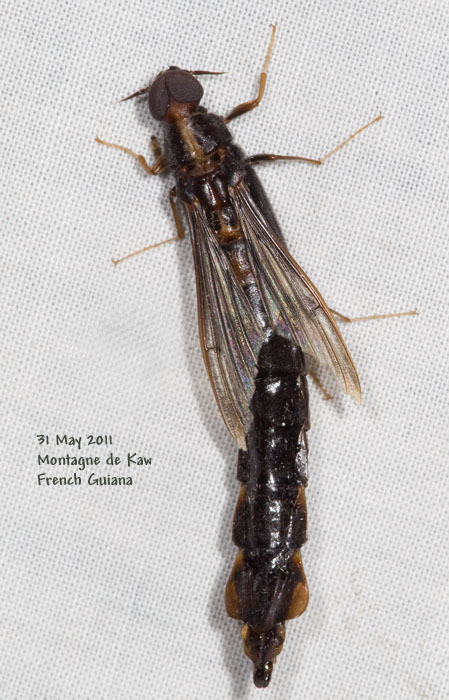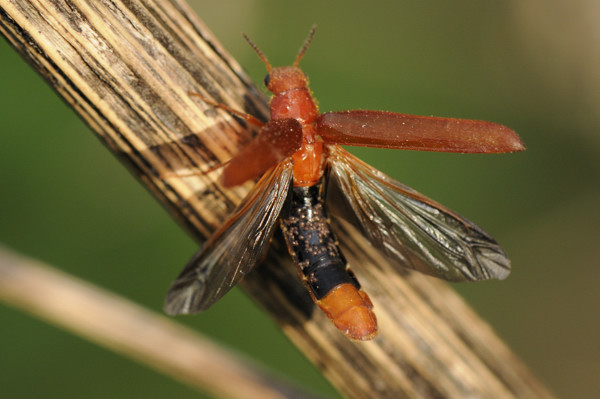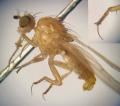Diptera.info :: Identification queries :: Other insects, spiders, etc.
|
A strange monster
|
|
| Stephen |
Posted on 14-09-2011 10:22
|
|
Member Location: West Virginia USA Posts: 1322 Joined: 12.04.05 |
I hope someone can tell me what this is!
Stephen attached the following image:  [106.17Kb] --Stephen Stephen Cresswell www.americaninsects.net |
| socrates |
Posted on 14-09-2011 10:57
|
|
Member Location: California Posts: 109 Joined: 11.02.07 |
resembles an empidoid fly.
tempus fugit |
|
|
|
| Paul Beuk |
Posted on 14-09-2011 12:26
|
|
Super Administrator Location: Netherlands Posts: 19403 Joined: 11.05.04 |
It is not a Dipteron (hence I moved it to the appropriate forum). I was wondering about a Coleopteron but my text books do not cover the extravagansa that is sometimes found in the neotropics to rule out that order. As far as I can telle the visible wings might well be the hind wings with the base covered with small 'elytra'. Anyway, the structure of the thoracic segments is such that most of the holometabolous insects seem to be ruled out (including Coleoptera...) because of the segmentation andthe longitudinal sutures.
Paul - - - - Paul Beuk on https://diptera.info |
| ChrisR |
Posted on 14-09-2011 16:48
|
|
Super Administrator Location: Reading, England Posts: 7706 Joined: 12.07.04 |
Yeah, I have seen these at light in French Guiana - they are Coleoptera. I can't remember which family they belong to but someone will know it 
Manager of the UK Species Inventory in the Angela Marmont Centre for UK Biodiversity at the Natural History Museum, London. |
| Jeroen K |
Posted on 14-09-2011 16:55
|
|
Member Location: Kapellen, Belgium Posts: 1141 Joined: 03.04.09 |
Lymexylidae |
|
|
|
| cthirion |
Posted on 14-09-2011 18:18
|
|
Member Location: Awirs (Flémalle) Belgique Posts: 901 Joined: 13.08.04 |
Super,i did not find! Camille cthirion |
| Tony Irwin |
Posted on 14-09-2011 20:39
|
|
Member Location: Norwich, England Posts: 7323 Joined: 19.11.04 |
Atractocerus sp.
Tony ---------- Tony Irwin |
|
|
|
| Stephen |
Posted on 14-09-2011 20:59
|
|
Member Location: West Virginia USA Posts: 1322 Joined: 12.04.05 |
Thanks, everyone! I posted it in this (non-diptera) forum first, but 60 seconds later delted it and reposted under adult diptera because I thought, "Nothing can have eyes that big and that faceted except a fly." I thought I saw only two wings, but of course I did not see halteres. Paul was wise enough to move it back to non-diptera. Fantastic, I am delighted to find out what it is, and it is a new family for me too. Thank-you! --Stephen Stephen Cresswell www.americaninsects.net |
| ChrisR |
Posted on 14-09-2011 23:38
|
|
Super Administrator Location: Reading, England Posts: 7706 Joined: 12.07.04 |
They really are an amazing insect and they make an incredible clattering noise when they arrive at light traps. I had 2 specimens for a while (until donating them to the BMNH) and I would regularly vex even experienced entomologists by asking them which order to put it in! 
Manager of the UK Species Inventory in the Angela Marmont Centre for UK Biodiversity at the Natural History Museum, London. |
| socrates |
Posted on 15-09-2011 15:04
|
|
Member Location: California Posts: 109 Joined: 11.02.07 |
amazing! the eyes are antennae appears like dipteran archetype as well as the wing folding type. were there any molecular study done for this taxon?
tempus fugit |
|
|
|
| nick upton |
Posted on 20-09-2011 14:21
|
|
Member Location: Wiltshire, UK Posts: 828 Joined: 12.03.10 |
I don't know if any molecular studies have been done, but the Lymexylidae is a really unusual and very ancient family, with fossil forms of this genus dating back 100milliion years and their lineage may go back to the early Jurassic from what I've read. Taxonomic links seem to be disputed based on morphology, but they may be close to Cleroidea or Cucujoidea or possibly Lampyridae. They're known as Ship-timber or Timberworm beetles as the larvae of some once attacked wooden ships, and they cause extra damage as they are among the very few insects that culture fungi to aid plant breakdown (as leafcutter ants and some termites do). The larvae of many genera much on rotted wood and fungi from what I can discover. There is some good info on this link: http://beetlesinthebush.wordpress.com/category/arthropoda/insecta/coleoptera/lymexylidae/ I have photographed a European species Hylecoetus dermestoides in Germany, attached below, which looks much more like a typical beetle with longer elytra and I actually thought it was a large soldier beetle (Cantharidae) until i noticed some unusual features. Your beetle is really weird...and different with the tiny elytra and big head. The link above suggests the adults of Atractocerus spp. may actually be predatory, but little or nothing is known about their behaviour. So many beetles, so many with interesting stories.. nick upton attached the following image:  [116.96Kb] Nick Upton - naturalist and photographer |
|
|
|
| Jump to Forum: |













